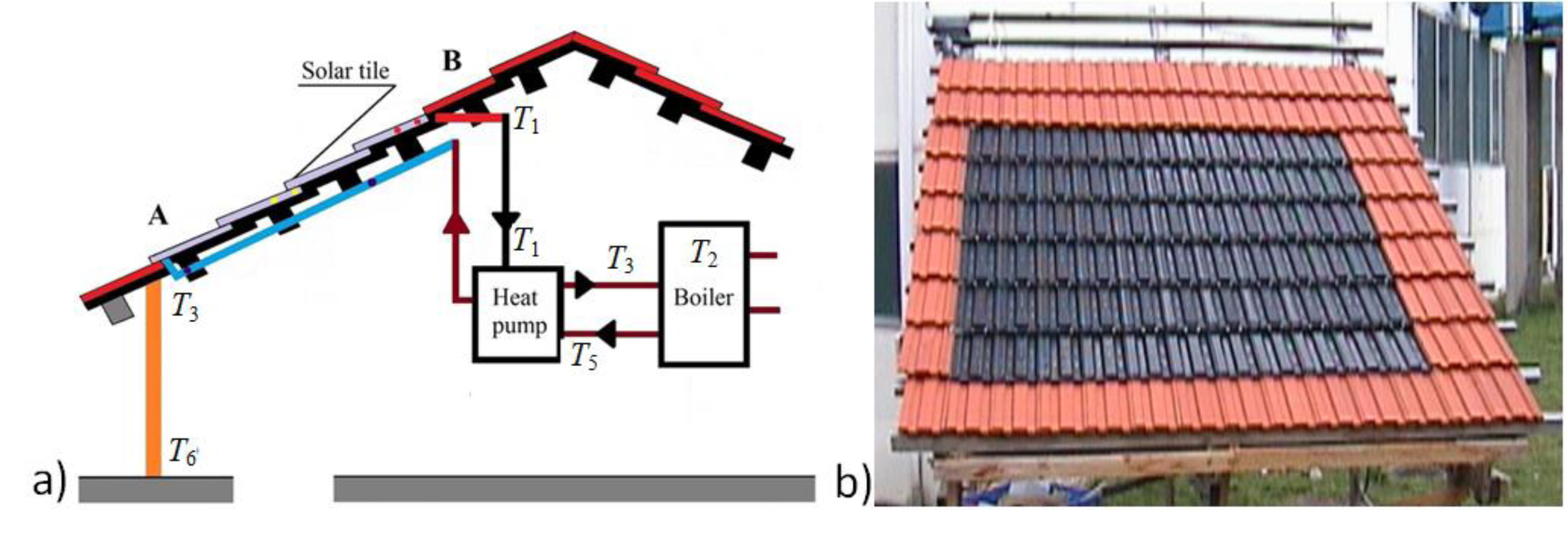Introduction
The paper deals with the use of combination solar tiles-heat pump for domestic water heating. The paper presents testing of solar tile-heat pump combination. Black-coloured water which absorbs solar radiation flows through solar tiles made of transparent polymethyl methacrylate CH2C(CH3)COOCH3. At the same time, solar tiles are used as a roof covering and as a solar radiation collector. Hot water from solar tiles is led to the heat pump, which increases the temperature of water entering the boiler heating coil. The heat of water heated in solar tiles serves as a source of anergy for the heat pump. On that way Coefficient of Performance (COP) of heat pump is increased. Since we wanted to evaluate realistically the efficiency of combimation solar tiles-heat pump, we carried out extensive tests. The experiments were carried out in rainy, cloudy and clear weather.
Test rig
Conventionally, all types of collectors and heat pumps are used separately. In the paper, it is a suggestion to join both systems in a serial connection. Heated water that is coming from the solar tiles is led directly into the input side of a heat pump to gain the higher temperatures. This serial connection should ensure higher temperatures of heating as each heating system works independently.
To verify the effectiveness of the serial connection solar tiles – heat pump, a convenient test rig was built. Measurements of suitable quantities were carried out and analyzed. The test rig consists of a solar tiles, water-water heat pump, and boiler.
The tests were carried under various weather conditions in the summer and winter seasons. Inlet and outlet temperatures from the flat plate collector and heat pump were measured, as well as the ambient air temperature and the water temperature in the boiler.
Figure 1a shows a measurement diagram and Figure 1b the installation of solar tiles. The surface area of tiles was 2 m2. On the lower side, the tiles were insulated, resulting in a decrease by half of the contact surface of the air with the tiles in the case of cloudy weather and darkness, when convective heat transfer prevails. The insulation is appropriate when heat is generated from the radiant part of the heat transfer. The water/water heat pump had thermal power of 1.5 kW under standard conditions and it heated a 300 l boiler. The measured parameters included:

Figure 1. a) Measurement diagram, b) Installation of solar tiles
- outlet water temperature from a solar tile (T1);
- boiler water temperature (T2);
- inlet water temperature to a solar tile (T3);
- outlet water temperature from a heat pump (T4);
- inlet water temperature to a heat pump (T5);
- ambient air temperature (T6);
- water flow (Q).
Tests results
The measurements shown in Figure 2 were made in clear sunny and totally cloudy weather. The difference between temperatures T1 (outlet water temperature from a solar tile) and T6 (ambient air temperature) was as high as 20 °C. Between 13:00 and 15:30, it was totally cloudy, which is why the T1-T6 difference dropped to 0 °C. At 15:30, the sky was fully cleared and the temperature difference increased again to 8 °C. From an energy point of view, the solar tile-heat pump combination is certainly the best solution in clear weather for heating of residential houses and domestic water.

Figure 2. Temperature measurements – Weather: sunny and windy
References
- Dubey S and Tiwari GN (2009) Analysis of PV/T flat plate water collectors connected in series. Solar Energy 83: 1485–1498.
- Haložan H (2000) Heat-Pumping Technologies, Journal of Mechanical Engineering. 46: 2000: 445–453.